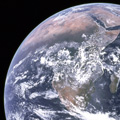Global and Regional Ecology
Editor(s):
|
We live in a world where humans are increasingly changing the physical and chemical environment at a global scale. Climate is warming, the populations of many species are in decline, pollution is affecting ecosystems and human health, and human societies now face new risks in terms of sea-level changes, disease, food security, and climate extremes.
This has fostered a greater awareness by scientists of ecology at spatial scales larger than ecosystems. Scientists who study global environmental change are interested in learning how drivers of environmental change (including human population growth and consumption, energy use, land use changes, and pollution) impact biological systems across many scales — from the level of the individual organism, to populations, communities, and ecosystems. They study structure, process, and change within the context of global systems.
The emergence of the global perspective has been driven by the development of tools such as aerial photography, remote sensing satellites, geographic information systems (GIS), handheld global positioning systems (GPS), and radiotelemetry that allow scientists to view the environment at larger scales. As well, the ability to analyze this information is constantly growing thanks to better computers, new statistical methods, and computer models.
Landscape ecology is a subdiscipline of global ecology that focuses on understanding the extent, origin, and ecological consequence of spatial heterogeneity across a range of scales. Landscape ecology specifically recognizes that disturbance, whether anthropogenic or caused by natural processes, creates spatial heterogeneity that is the normal condition of ecosystems.
Concepts and methods from landscape ecology, which focus specifically on causes and consequences of spatial heterogeneity for ecological processes, have converged with research efforts in population and community ecology to create the recognized area of study called spatial ecology. Spatial ecology centers on how specific spatial arrangements of organisms, populations, and landscapes influence ecological dynamics. In particular, much of spatial ecology is closely related to conservation biology because it emphasizes the study of habitat loss and fragmentation caused by human activities.
Scientists in these fields of global ecology are tackling a whole host of environmental issues that we face in the twenty-first century, and the field is rapidly growing. To develop a rich understanding of global ecology, begin with this introductory overview, and then explore the more than twenty other summaries you’ll find below.
This has fostered a greater awareness by scientists of ecology at spatial scales larger than ecosystems. Scientists who study global environmental change are interested in learning how drivers of environmental change (including human population growth and consumption, energy use, land use changes, and pollution) impact biological systems across many scales — from the level of the individual organism, to populations, communities, and ecosystems. They study structure, process, and change within the context of global systems.
The emergence of the global perspective has been driven by the development of tools such as aerial photography, remote sensing satellites, geographic information systems (GIS), handheld global positioning systems (GPS), and radiotelemetry that allow scientists to view the environment at larger scales. As well, the ability to analyze this information is constantly growing thanks to better computers, new statistical methods, and computer models.
Landscape ecology is a subdiscipline of global ecology that focuses on understanding the extent, origin, and ecological consequence of spatial heterogeneity across a range of scales. Landscape ecology specifically recognizes that disturbance, whether anthropogenic or caused by natural processes, creates spatial heterogeneity that is the normal condition of ecosystems.
Concepts and methods from landscape ecology, which focus specifically on causes and consequences of spatial heterogeneity for ecological processes, have converged with research efforts in population and community ecology to create the recognized area of study called spatial ecology. Spatial ecology centers on how specific spatial arrangements of organisms, populations, and landscapes influence ecological dynamics. In particular, much of spatial ecology is closely related to conservation biology because it emphasizes the study of habitat loss and fragmentation caused by human activities.
Scientists in these fields of global ecology are tackling a whole host of environmental issues that we face in the twenty-first century, and the field is rapidly growing. To develop a rich understanding of global ecology, begin with this introductory overview, and then explore the more than twenty other summaries you’ll find below.
Explore This Subject
Key Challenges
Ecosystem Processes: Energy Flows and Biogeochemical Cycling
Miscellaneous
Scientific Perspectives
Biogeography: Distribution, Dispersal, and Diversification of Organisms
Earth's Climate System
Methods in Research and Monitoring














